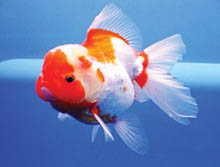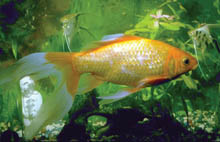|
observer |
|
|
|
|
|
OTHER LINKS |

|

|

|
|
|
|
|
The size of your fish tank depends on how many gold fish you'll be having and the place where you are going to keep the tank. But, we should provide as much space as possible for the fish. The more water you have per fish, the more diluted fish waste will be.
This will help prevent diseases and promote proper fish growth. If the tank is big enough, the fish will have more oxygen. Usually, a fish around one inch in length needs one gallon of water. Five young gold fish, each two inches long, would initially be ideal in a ten gallon aquarium. But, after a while, when they grow three to four inches, they will find the tank a bit crowded.
|
|
So, if you want to rear gold fish, you would be better off starting with a 15 or 20 gallon aquarium. Usually, gold fish grow better in an environment temperature of between 18 and 22 degrees Celsius. Filteration is most important in a tank. If there are water plants, so much the better.
The basic needs of a gold fish are oxygen, food and shelter. Aquatic plants provide all three. When including plants in a tank, we should think about the environment for the plants; water condition, temperature, lighting and air required for the plant are some of them.
How to prepare the tank
First, we must wash the tank thoroughly. For this, we shouldn't use hot water or detergents; hot water can crack the glass and detergents can be poisonous for the fish. A strong salt solution can be used to clean the aquarium. We can make it by adding six tablespoons of salt to a gallon of water.
Arrangement of gravel
The colour and size of the gravel will affect the beauty of the tank. Black and brown gravel will enhance the beauty of the gold fish better than light coloured gravel.
The gravel must be cleaned before being used, in a separate basket. It should be kept in an aquarium in a way that maintenance is easier. The gravel should be arranged in such a way that it slopes downward, towards the front centre part of the aquarium. This will help all the dirt to gather in one place, without being deposited everywhere.
Decorative rocks must be relatively hard and should not have holes or cracks in them. If not, fish food will be deposited in these places and will make the water stink. Petrified (hardened) wood, or stones are also safe, but sea shells or pieces of coral should never be used because they can contain pieces of fish, which can make the water stink. If the water stinks, that means it has become alkaline, which is not good for fish.
There is also a possibility fish can knock against these objects and become injured.
When buying fish...
When you go into a shop to buy aquarium fish, you must check whether the tanks in that shop are clean and whether there are any dead fish in the tanks. Tanks should be covered; otherwise insects can enter them.
If there is just one dead fish in a tank, it's alright, but if there are more than two dead fish in a tank, don't buy fish from that shop. Before you buy fish from a shop, you must check the colour of the water in the tank. If it is not a normal colour, it means they have used medicine for the water.
If they have used medicine in all the tanks, it is better to avoid buying fish from that shop. If there are just one or two tanks containing such water, it's alright as even professional fish breeders can have injured fish, but avoid buying fish from those particular tanks.
Also, check whether they use a separate net for each tank, because a net is the main source of spreading diseases among fish. When you are buying fish, check whether there are any sick fish in the tank.
If the fish rub or scratch themselves against objects in the aquarium, they could be suffering from fin rot, mouth or body fungus or ulcers. We'll see you again with more fish facts. Until then, happy fishing











